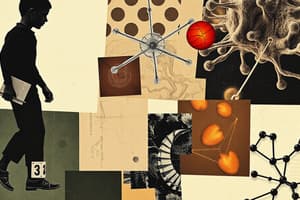Podcast
Questions and Answers
How do auxins promote root growth in plants?
How do auxins promote root growth in plants?
- By increasing the pH of cell walls
- By promoting trophic responses to light
- By inhibiting the growth of lateral buds
- By causing cell elongation through the active transport of hydrogen ions (correct)
What is the main function of auxins in maintaining apical dominance?
What is the main function of auxins in maintaining apical dominance?
- To promote lateral bud growth
- To inhibit lateral bud growth (correct)
- To enhance cell expansion and growth
- To facilitate root growth
How do auxins contribute to phototropism in plants?
How do auxins contribute to phototropism in plants?
- By suppressing the release of second messengers
- By lowering the pH of cell walls
- By inhibiting the translocation of nutrients
- By promoting the elongation of cells towards light (correct)
What is the role of auxins in cellular metabolism?
What is the role of auxins in cellular metabolism?
How do auxins affect the flexibility of cell walls?
How do auxins affect the flexibility of cell walls?
In which process do auxins primarily assist when plants are exposed to light from all directions?
In which process do auxins primarily assist when plants are exposed to light from all directions?
What is the main purpose of homeostasis in organisms?
What is the main purpose of homeostasis in organisms?
Which of the following is NOT controlled by homeostasis?
Which of the following is NOT controlled by homeostasis?
What is the role of negative feedback in maintaining homeostasis?
What is the role of negative feedback in maintaining homeostasis?
How do hormones affect target organs and cells?
How do hormones affect target organs and cells?
In positive feedback mechanisms, how do responses differ from negative feedback?
In positive feedback mechanisms, how do responses differ from negative feedback?
What is the role of auxins when a shoot is illuminated from only one side?
What is the role of auxins when a shoot is illuminated from only one side?
How do gibberellins stimulate germination?
How do gibberellins stimulate germination?
Which hormone promotes cell division in apical meristems and lateral bud development?
Which hormone promotes cell division in apical meristems and lateral bud development?
How do phytochrome levels affect flowering in long-day plants?
How do phytochrome levels affect flowering in long-day plants?
What is the relationship between auxins and cytokinins in terms of apical dominance?
What is the relationship between auxins and cytokinins in terms of apical dominance?
What form of phytochrome exists as the biologically active form, absorbing far red light?
What form of phytochrome exists as the biologically active form, absorbing far red light?
Flashcards are hidden until you start studying
Study Notes
Auxins and Plant Growth
- Auxins promote root growth by increasing cell elongation and cell division in the root tip.
- Auxins maintain apical dominance by inhibiting the growth of lateral buds, allowing the main stem to grow longer and stronger.
- Auxins contribute to phototropism by stimulating cell elongation on the side of the stem away from light, causing the stem to bend towards the light source.
Auxins and Cellular Metabolism
- Auxins play a role in cellular metabolism by regulating cell wall loosening, allowing for cell expansion and growth.
- Auxins affect the flexibility of cell walls by breaking down cellulose and increasing the synthesis of new cell wall components.
Light Response and Homeostasis
- Auxins assist in the process of phototropism when plants are exposed to light from all directions.
- The main purpose of homeostasis in organisms is to maintain a stable internal environment despite changes in the external environment.
- Homeostasis does not control evolutionary processes.
- Negative feedback mechanisms help maintain homeostasis by reducing or reversing the response to a stimulus once the desired outcome is achieved.
Hormone Function and Interactions
- Hormones affect target organs and cells by binding to specific receptors, triggering a response.
- In positive feedback mechanisms, responses amplify or increase the initial stimulus, whereas in negative feedback mechanisms, responses reduce or reverse the initial stimulus.
- Auxins promote cell elongation on the side of the stem away from light when a shoot is illuminated from only one side.
- Gibberellins stimulate germination by breaking seed dormancy and promoting seedling growth.
- Cytokinins promote cell division in apical meristems and lateral bud development, reducing apical dominance.
- Phytochrome levels affect flowering in long-day plants by promoting flowering in response to long days.
- Auxins and cytokinins have an antagonistic relationship in terms of apical dominance, with auxins promoting apical dominance and cytokinins inhibiting it.
- The biologically active form of phytochrome is Pfr, which absorbs far-red light.
Studying That Suits You
Use AI to generate personalized quizzes and flashcards to suit your learning preferences.



